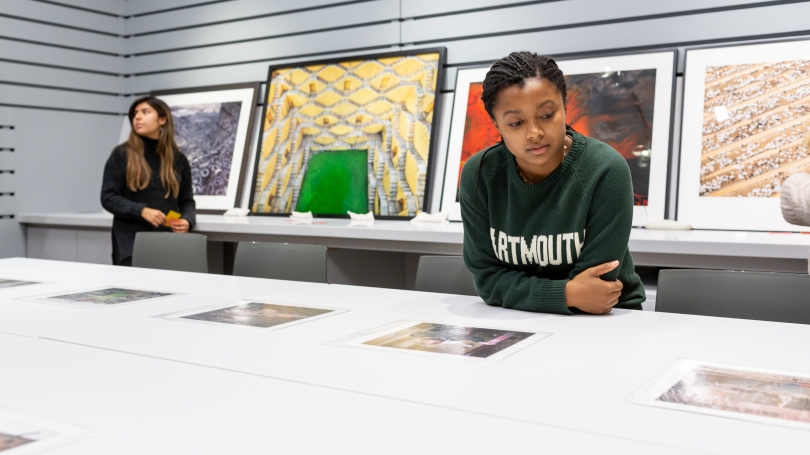Reflections and Revelations on A Space for Dialogue
As the weather gets warmer, we are all starting to think about getting outside after a long winter, but I urge you to also continue to spend some time indoors looking at works of art and the ways in which artists capture and augment the natural world. As my Hood internship ends, I reflect on my time here on Dartmouth's campus and what it means to go to school at the Big Green. The Hood Internship Program has allowed me to have one foot in the museum world and one in the classroom. The museum staff constantly encourages my academic pursuits and each term my final projects for many of my courses have integrated works from the Hood's collection.
In my final quarter at Dartmouth, I finally enrolled in my first English course, Introduction to African American Environmental Thought: The Black Outdoors. Assistant Professor of English and Creative Writing Joshua Bennett's course seeks to examine the relationship between the black experience and nature through the lens of authors like Toni Morrison and Zora Neale Hurston, and movies such as Moonlight and Jordan Peale's Get Out.
While taking this course, I began to reexamine my own A Space for Dialogue exhibition, Black Bodies on the Cross, which explores the intersections of the black experience, colonization, and Christianity. Often in Christian iconography, biblical characters are portrayed as white, but the works included in my exhibition reimagine these main characters as black. How do we reinterpret these well-known biblical stories when the main characters are black?
When I designed my exhibition, I never thought about how central nature is to our understanding of religion, and to what degree the natural world was represented throughout many of the works in my exhibition. In class, we think critically about the intersections of the natural world and blackness and I am now able to express some the connections I was subconsciously making through the framework of black environmental theory.
Romare Bearden's In the Garden, a central work in my exhibition, captures many of these tensions through its inclusion of a "conjur" woman, a powerful healing figure in Hoodoo culture. Bearden defines the conjur woman in his 1968 essay My Rectangular and Structure in My Montage Paintings as "an important figure in a number of southern Negro rural communities . . . called on to prepare love potions; to provide herbs to cure various illnesses; and to be consulted regarding vexing personal and family problems." In Professor Bennett's class, we read excerpts from Charles W. Chesnutt's The Conjure Woman which helped me to further understand the nuances of the conjur woman's presence and connectivity to nature within the black communities. Bearden places the conjur woman in the garden of Eden, further examining the ways in which Hoodoo, Christianity, and nature coexist within the black experience. In the work, Bearden contrasts bright colors, making a black woman the central focus of the composition as she tends to the birds and plant life. Some art historians read her as Eve, but I believe she is in an independent entity outside of the birth of original sin, representing uncorrupted harmony with nature.
I look forward to the opening of my student exhibition and am excited to incorporate my new love of environmental black theory into the way we think about biblical representations in art. I encourage visitors to think about how nature affects our lives here at Dartmouth, and how the campus's isolation and colonial associations with the "wilderness" contribute to our perceptions of the natural world. And about what it means to be "surrounded by the trees and Ivy League," as singer J. Cole wrote in his song "Neighbors."
Written by Victoria McCraven, Homma Family Intern for Curatorial
Editor's Note: Victoria's Space for Dialogue installation "Black Bodies on the Cross" will be on view at the Hood Museum of Art from November 9 through January 4, 2020.
